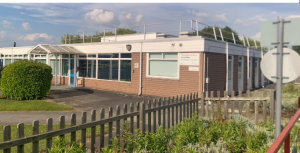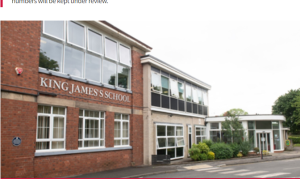A recent analysis reveals that secondary schools in Harrogate and Knaresborough have much worse Ofsted ratings than the county and national average.
According to the research, local secondary schools receive among the lowest funding levels in the nation, coming in at number 141 out of 150 for funding per student.
On the other hand, primary schools receive more funding and achieve higher-than-average Ofsted ratings both nationally and locally.
The report was written for the Harrogate and Knaresborough area constituency committee of North Yorkshire Council, which will meet on Thursday, March 14.
Written by senior council officers, it highlights the need for new schools and provides an overview of attainment, funding, and special education requirements.
The Harrogate and Knaresborough electoral area, which encompasses Boroughbridge until the next general election, has 29 primary schools. Eight are run by the council, and twenty-one are academies or free schools. There are no independent schools listed.
There are seven secondary schools: two are managed by the council and five are part of academies. One student referral unit and two special schools are also present.
The main conclusions of the report are outlined here.
Ofsted woes
57% of secondary schools in Harrogate and Knaresborough were rated as excellent or exceptional as of January 2024, a significantly lower percentage than the norms for North Yorkshire (83%) and the country (79%).
However, more Harrogate and Knaresborough primary schools—97%—were rated as excellent or exceptional than the norm for North Yorkshire (86%) and the country (91%).
The report states the following about key stage attainment levels:
“In North Yorkshire, attainment appears to have returned to pre-pandemic levels and is now very similar to national attainment levels.”
Special educational needs soaring
According to the report, 883 children (18% of the North Yorkshire total) in Harrogate and Knaresborough received an education, health, and care plan financed by North Yorkshire in January of this year.
EHC plans specify the extra support needed to address social, health, and educational needs. The three most prevalent local requirements are: mild learning difficulties (11%) and social emotional and mental health (18%), followed by autism (46%).
In 2023, North Yorkshire Council received 1,275 requests for an EHC plan, which is a 30% increase from the previous year and the largest number since they were introduced. Of these, 199 (16%) were for Knaresborough and Harrogate youth.
According to the report:
“At the time of writing, about 600 requests were either in the process of being finalised, awaiting a plan to be issued, or awaiting an assessment judgement.
About 300 were in process at the same time last year. Due to a severe national scarcity of educational psychologists, it is more difficult to obtain the data needed to make choices about EHC plan assessments, which is at least partially responsible for the increase in requests currently under review.
“North Yorkshire Council has addressed a backlog in receiving advice from educational psychologist services by contracting agencies to handle the challenge.”
The report also stated that several trainee and part-time educational psychologists, as well as a main educational psychologist, had been hired as a result of “a successful recruitment drive.” It also says:
This is expected to have a consequent effect of an upturn in overall timeliness in final plans being issued towards through the year.”
Home education increasing
Ninety-five of the 817 children in North Yorkshire who were registered as electively home-schooled at the start of the 2023–2024 school year had previously attended conventional schools in Knaresborough and Harrogate. The number has increased by 9% from the 87 in the constituency the previous year.
The report also states that in 2022–2023, students attending mainstream schools in Harrogate and Knaresborough accounted for 10 of the 96 permanent exclusions from all county schools. And the number was ten the previous year.
Low secondary school funding
In terms of financing per pupil, North Yorkshire secondary schools rank 141st out of 150 local authorities. Compared to the national average of £6,542, a school in North Yorkshire will receive £5,994 per student on average in 2023–2024. When comparing the financing for a secondary school with 1,500 students, this results in a £0.82 million funding gap.
When it comes to financing per pupil, North Yorkshire primary schools are ranked 32nd out of 150 local authorities. A North Yorkshire primary school will receive £5,125 per student on average, whereas the national average is £5,014.
School budgets “have experienced significant cost pressures in the 2023/24 financial year,” according to the report.
The tensions are increased by a 6.5% salary reward for teachers in
Rural school closures?
Woodfield Community Primary School in Bilton closed in December 2022 and several rural schools have also ceased operating in North Yorkshire in recent years.
The report provides little reassurance that others won’t follow. It says the council is “carefully monitoring pupil numbers across the Harrogate and Knaresborough constituency area”, adding:
“A number of small schools are facing financial challenges associated with low numbers on roll due to a falling birth rate combined with changing demographics.”
According to the report, “a number of small schools are facing multiple challenges associated with low numbers on roll” as a result of decreased birth rates and rural population declines.
Primary school changes
The report says council officers are “monitoring the situation carefully in Boroughbridge town and Kirby Hill in terms of school place planning” due to the number of new houses.
It adds:

“Birkbridge Community Primary School will have additional capacity (60 places), and construction is anticipated to begin in the summer of 2024.”
Regarding “substantial housing development” in the west of Harrogate, it states:
Provisional indications have been made for the locations of two primary school sites: Windmill Farm on H49 and Land East of Whinney Lane on H51. Furthermore, Penny Pot Lane has been secured by the local council as an extra educational facility.
“We are currently monitoring the pace of housing development and its impact on the need for additional school places. Housing development has started at Penny Pot Lane.”
It also states that Oatlands Junior School now has “additional capacity.”
At Killinghall CE School, three new classrooms have been erected since 2017.
In 2020, plans were approved for a primary school with 210 students at Manse Farm in Knaresborough; however, no construction has been done, and the situation seems to be at a standstill. According to the report:
“The council is still actively pushing the parties involved to find a solution to the problems that are impeding the council’s acquisition of the school land.
“The council will only be able to review and validate its plans for the proposed school once this is accomplished.”
Secondary school changes
Two classrooms and three classrooms have added capacity to Rossett School and Harrogate Grammar School respectively, the report says. It adds:
“Both will assist in meeting the expected rise in demand for places as a result of housing growth but pupil numbers will be kept under review.”
The report states that King James’s School in Knaresborough has “sufficient places for local children” based on data.
The goal opening date of the proposal to turn the former Woodfield Community Primary School into a special school for kids with autism has been pushed back from September of this year to April of 2025.
A plan is in the works to offer more special school seats at Springwater School starting in September 2025Maltkiln
Two primary school locations are planned for Maltkiln, a new town that is expected to be built close to Cattal and could house 10,000 people. According to the report:
“It is not anticipated that the scale of the entire growth would result in a number of students needing to be enrolled in a new secondary school.
The plan is to enlarge Boroughbridge High School in order to accommodate the projected increase in secondary enrollment resulting from the expansion. In the event that it becomes necessary in the future, proposals for Maltkiln suggest protected territory for secondary provision.

Leave a Reply